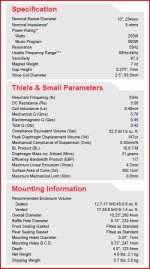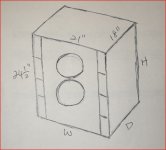Guys,
Lately I got 4 2510 10" and would love to make couple Onken bass box for my future project. My intention is to put 2 drivers in one box and aim at highest db as possible so to cope with my 2A3 and 300B amps. I really would love to match it with a mid horn and a tweeter. I've been searching all over the forum and seems not too many Onken box with 10" driver. I finally come with a calculation posted by GM and have the following result. I know the result doesn't look right and I have to admit that I'm not good on math.
Please take a look at the attachment and I'd appreciate any ideas provided.
BR
Albert
Lately I got 4 2510 10" and would love to make couple Onken bass box for my future project. My intention is to put 2 drivers in one box and aim at highest db as possible so to cope with my 2A3 and 300B amps. I really would love to match it with a mid horn and a tweeter. I've been searching all over the forum and seems not too many Onken box with 10" driver. I finally come with a calculation posted by GM and have the following result. I know the result doesn't look right and I have to admit that I'm not good on math.
Please take a look at the attachment and I'd appreciate any ideas provided.
BR
Albert
Attachments
The following should come with
ONKEN CALCULATOR by Cyr-Marc Debien 2000 © cdebien@cmaisonneuve.qc.ca
After original research from M. Eijiro Koïzumi and Jacques Mahul and Jean Hiraga calculations.
Koïzumi factor K= 1.57 K= 83.210 Hz
You can modify the RED value. The Green Value are calculated by the software. In many case it's for validation.
TS parameters
Fs 53.000 Hz driver frequency resonnance
Re 5.060 ohms dc resistance of driver
Qms 5.760 mechanical Q of the driver
Qes 0.450 electrical Q of the driver
Qts 0.417 total Q of driver at Fs calculated by the software
Mms/d 31.000 gr total cone assembly mass
Sd 3.501E+00 m^2 effective radiation area of the driver cone
Rg 0.300 ohms total components resistance (xover coil, terminal, wire, amplifier, etc.)
Cms 2.91E-04 driver suspension compliance calculated by the software
Vas 499309.099 litres air volume driver compliance calculated by the software
Vas*Qts2 96774.541 calculated by the software
n = 6.340 (best 5.7) Onken alignment (best alignment = 5.7, Onken alignment = 6.34)
note : you can play with the n factor to maintain the L' vent under 30 cm
but try to don't used a excessive value because you don' t respect the Onken approach
Box and system response
F-3 47.812 Hz box cutoff frequency at -3dB
Fb 46.951 Hz box cutoff frequency
Cab 43825.042 acoustical box compliance 0.477
Map 0.003 acoustical mass box 0.440
S vent 304.000 cm^2 this value is calculated by the vent dimension section 0.000
nO 159.243 Vas*Qts2’ 96774.541
dB 1w/1m 133.520 dB total efficiency of the system including Rg
Vent lenght
L vent 0.006 cm effective lenght vent
L’ vent -9.732 cm corrected effective vent lenght (use this lenght in your vent calculation)
note : If the L' vent is over 35 cm, your driver is not suitable for the Onken speaker application
Vent dimension (habitually an Onken speaker have a S vent equal or -15 % smaller to the driver Sd)
Width 4.000 cm indicate the width of one vent
Height 9.500 cm indicate the height of one vent
Quantity 8.000 indicate the number of vent you can use (Onken speaker have 6 or 8 identical vent)
S vent 304.000 cm^2 total vent area (try to obtain a S vent equal or maximum 15% less to the Sd)
Vent volume -2.959 litres total volume occupied by all vent in the box
Total Box Volume
Vb 613550.590 litres total internal volume of the box
Vb Total 613547.631 litres total internal volume of the box plus the required volume for the vent
I filled in all numbers I know on the red box and come up with the above numbers.
ONKEN CALCULATOR by Cyr-Marc Debien 2000 © cdebien@cmaisonneuve.qc.ca
After original research from M. Eijiro Koïzumi and Jacques Mahul and Jean Hiraga calculations.
Koïzumi factor K= 1.57 K= 83.210 Hz
You can modify the RED value. The Green Value are calculated by the software. In many case it's for validation.
TS parameters
Fs 53.000 Hz driver frequency resonnance
Re 5.060 ohms dc resistance of driver
Qms 5.760 mechanical Q of the driver
Qes 0.450 electrical Q of the driver
Qts 0.417 total Q of driver at Fs calculated by the software
Mms/d 31.000 gr total cone assembly mass
Sd 3.501E+00 m^2 effective radiation area of the driver cone
Rg 0.300 ohms total components resistance (xover coil, terminal, wire, amplifier, etc.)
Cms 2.91E-04 driver suspension compliance calculated by the software
Vas 499309.099 litres air volume driver compliance calculated by the software
Vas*Qts2 96774.541 calculated by the software
n = 6.340 (best 5.7) Onken alignment (best alignment = 5.7, Onken alignment = 6.34)
note : you can play with the n factor to maintain the L' vent under 30 cm
but try to don't used a excessive value because you don' t respect the Onken approach
Box and system response
F-3 47.812 Hz box cutoff frequency at -3dB
Fb 46.951 Hz box cutoff frequency
Cab 43825.042 acoustical box compliance 0.477
Map 0.003 acoustical mass box 0.440
S vent 304.000 cm^2 this value is calculated by the vent dimension section 0.000
nO 159.243 Vas*Qts2’ 96774.541
dB 1w/1m 133.520 dB total efficiency of the system including Rg
Vent lenght
L vent 0.006 cm effective lenght vent
L’ vent -9.732 cm corrected effective vent lenght (use this lenght in your vent calculation)
note : If the L' vent is over 35 cm, your driver is not suitable for the Onken speaker application
Vent dimension (habitually an Onken speaker have a S vent equal or -15 % smaller to the driver Sd)
Width 4.000 cm indicate the width of one vent
Height 9.500 cm indicate the height of one vent
Quantity 8.000 indicate the number of vent you can use (Onken speaker have 6 or 8 identical vent)
S vent 304.000 cm^2 total vent area (try to obtain a S vent equal or maximum 15% less to the Sd)
Vent volume -2.959 litres total volume occupied by all vent in the box
Total Box Volume
Vb 613550.590 litres total internal volume of the box
Vb Total 613547.631 litres total internal volume of the box plus the required volume for the vent
I filled in all numbers I know on the red box and come up with the above numbers.
According to my spreadsheet based on the "Petite Onken" article you get for two drivers in one box:
Vb=117dm3, F3=50,1Hz, Sev=700cm2/L=53cm.
Unfortunately this isn´t the optimal Onken, as F3 is to high and L is to long.
Using the pair in a 3m long, 35Hz basshorn and 1075dm3 volume sims very well though. Over 115dB sensitivity!
Vb=117dm3, F3=50,1Hz, Sev=700cm2/L=53cm.
Unfortunately this isn´t the optimal Onken, as F3 is to high and L is to long.
Using the pair in a 3m long, 35Hz basshorn and 1075dm3 volume sims very well though. Over 115dB sensitivity!
Last edited:
Don't worry about it albert. You seem to have done ur research. Go for the build, and let us know how it turns out.
I want to build, but the size of box volume doesn't look right to me.
Using your data on the Onken spreadsheet and using the two speakers in parallel
I get the following, provided I have entered the data correctly:
jamikl
Jamikl,
Thanks for the help.
Now I got 2 box volume. Which one I should go for, the 149.337 litres/or 165.781 litres. Also I have 8 vent, 4.25 x 15 cm each. How deep ??
Albert
I finally come with a calculation posted by GM and have the following result.
Sd 3.501E+00 m^2 effective radiation area of the driver cone
Rg 0.300 ohms total components resistance (xover coil, terminal, wire, amplifier, etc.)
Vas 499309.099 litres air volume driver compliance calculated by the software
vent lenght
L vent 0.006 cm effective lenght vent
L’ vent -9.732 cm corrected effective vent lenght (use this lenght in your vent calculation)
Vent volume -2.959 litres total volume occupied by all vent in the box
Total Box Volume
Vb 613550.590 litres total internal volume of the box
Vb Total 613547.631 litres total internal volume of the box plus the required volume for the vent
Greets!
You mentioned this before, but don't know what you're referring to. For sure, this isn't based on any calculation I've posted.
I'm not good at math either, but fortunately one doesn't need to know any math more complex than addition, subtraction, division to use CMB's spreadsheet [SS] calculator. Unfortunately for most folks who come to these forums though is that it requires you have a basic understanding of what you're inputting when using a calculator that requires more than the basic T/S specs ['Fs', 'Vas', 'Qts'] and in the case where multiple drivers are desired, how to change the specs to get an accurate calculation.
For the math challenged, he further complicated it by using scientific notation and m^2 for 'Sd' instead of the more common cm^2, which is where you messed up, so one must have a conversion chart or program such as 'Convert' to help folks like us.
To convert cm^2 to m^2 requires dividing it by 10,000, so would be inputted as 0.03501 which the SS will display as 3.501E-02.
With this change, 'Vas' will shrink by a factor of 10,000 which will then allow the SS to calculate a more reasonably sized box with vents that can actually be built in accordance with the physical laws of our universe.
Note that I get a ~5.15% smaller cab using CMD's designer compared to mine for a N=6.34 alignment due to the difference in Vas, so there's some minor discrepancies in the 2510's other published specs and of course measured specs may make either off by a higher percentage.
Finally, you only simmed one driver, not two, which requires a bit more simple math to combine their specs: http://www.quarter-wave.com/General/Two_Drivers.pdf
The easy way to design a two driver cab is to just design for one driver and double 'Vb', 'Vb total' and the vent's height or whatever you prefer to do to double the vent area.
You list Rg = 0.3 ohms which might not even account for all of any XO resistance if a passive is used and tube amps, especially SETs, can have a very high output impedance that will dramatically increase the cab's size due to it raising Qts. Also, to maximize wide BW efficiency with these types of amps it's common to series wire drivers to sum inductance ['Le'] and raise 'Re' which also minimizes any added series resistance impact on Qts.
Regardless, like most modern drivers, this one has specs designed to work well in a relatively small cab to meet the performance needs of a prosound application [app] with the design trade-off being lower efficiency, so isn't suitable for a 'pure' Onken loading.
Of course you can either reduce the vent area to as little as 70% of Sd to get them as short as practical and/or accept the stronger pipe harmonics of longer vents which can be damped empirically if they audibly 'color' [distort] the mids too much.
GM
- Status
- This old topic is closed. If you want to reopen this topic, contact a moderator using the "Report Post" button.
- Home
- Loudspeakers
- Multi-Way
- Onken bass box with 2 Eminence Deltalite ll 2510 10" bass drivers

